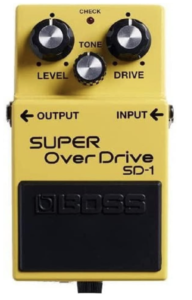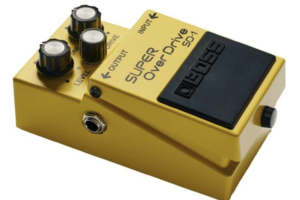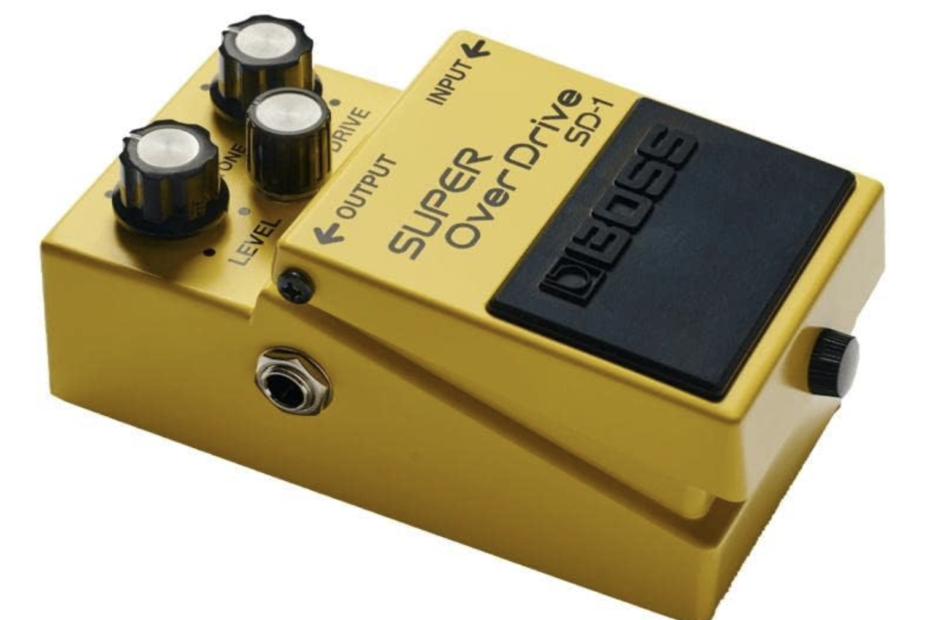The world of guitar pedals is a vast landscape, adorned with an array of effects that shape the soundscape of modern music. Among these gems, the Boss SD-1 Overdrive stands tall as an iconic legend, cherished by musicians worldwide for its warm and timeless overdrive tones. In this article, we delve into the history, features, and sonic delights of the Boss SD-1, discovering why it remains a staple on countless pedalboards.
Main Features
 The Boss SD-1 Super Overdrive is a classic pedal known for its simple yet effective design and versatile overdrive tones. Here are its main features:
The Boss SD-1 Super Overdrive is a classic pedal known for its simple yet effective design and versatile overdrive tones. Here are its main features:
- Three-Knob Layout: The SD-1 features a straightforward design with three knobs – Level, Tone, and Drive. These controls allow you to adjust the output volume (Level), overall brightness or darkness of the sound (Tone), and the amount of overdrive saturation applied to your signal (Drive).
- Transparent Overdrive: The SD-1 is revered for its transparent and organic overdrive character. It retains the natural tone of your guitar and amplifier while adding just the right amount of overdrive, making it an ideal choice for players who seek a pedal that enhances their sound without overpowering it.
- Versatility: With its wide range of overdrive tones, the SD-1 is suitable for various music genres. From smooth and creamy blues tones to cutting rock distortion, this pedal can adapt to different playing styles and musical contexts.
- Stacking Capability: The SD-1 pairs exceptionally well with other pedals and amplifiers. When used in combination with a driven tube amp or other dirt pedals, it provides cascading and harmonically rich sounds, offering endless possibilities for shaping your tone.
- Durable Construction: Housed in a rugged and compact enclosure, the Boss SD-1 is built to withstand the rigors of live performances and frequent use. Its classic Boss design ensures long-lasting durability.
- Affordable Price: The SD-1 offers high-quality overdrive tones at an affordable price point, making it accessible to guitarists of all levels.
- Iconic Legacy: The Boss SD-1 has earned a legendary status in the world of guitar effects, endorsed by renowned artists and used on countless recordings. Its timeless design and sound have made it a staple on pedalboards for decades.
- Battery or AC Power: The SD-1 can be powered using a 9-volt battery or a standard AC adapter, providing flexibility for different performance situations.
- LED Indicator: A built-in LED indicator lights up when the pedal is activated, allowing for easy visual monitoring during performances.
Check Low Price for BOSS SD-1 on Amazon!
The History of the Boss SD-1
 The Boss SD-1 Super Overdrive was first introduced in 1981, taking the music world by storm with its affordable price tag and impressive tonal capabilities. Designed by the pioneering engineer, Susumu Tamura, the SD-1 aimed to provide guitarists with a versatile overdrive pedal that could deliver the sounds of a cranked tube amplifier without breaking the bank.
The Boss SD-1 Super Overdrive was first introduced in 1981, taking the music world by storm with its affordable price tag and impressive tonal capabilities. Designed by the pioneering engineer, Susumu Tamura, the SD-1 aimed to provide guitarists with a versatile overdrive pedal that could deliver the sounds of a cranked tube amplifier without breaking the bank.
From its inception, the SD-1 found its way into the rigs of renowned artists, amplifying their signature sounds on countless records and stages. Over the decades, the pedal’s reputation has only grown, and its distinct overdrive character has become an essential component of many guitarists’ tonal arsenal.
Using the Pedal
Using the Boss SD-1 Super Overdrive is a breeze, and it can quickly become an essential tool on your pedalboard. Here’s a step-by-step guide on how to use the SD-1:
- Connections: Start by connecting your guitar to the input jack of the SD-1 pedal using a standard instrument cable. Then, connect the output jack of the pedal to your amplifier or the next pedal in your signal chain.
- Power: Ensure the SD-1 is powered using a 9-volt battery or a compatible AC adapter. You can find the power input on the side or back of the pedal, depending on the version you have.
- Gain Setting: Set the Drive knob to a minimum or at the 7 o’clock position for a clean signal. This setting means you are not applying any overdrive yet.
- Level Setting: Set the Level knob (volume) to your desired output level. Start at 12 o’clock and adjust it accordingly to match your amp’s volume or the desired overall volume when the pedal is engaged.
- Tone Control: The Tone knob is responsible for shaping the brightness or darkness of your tone. Experiment with different settings to find the right balance that suits your playing style and equipment.
- Activate the Pedal: To engage the SD-1, step on the footswitch located on the front of the pedal. When activated, the LED indicator will light up, indicating that the pedal is on.
- Applying Overdrive: Now comes the fun part! Gradually turn the Drive knob clockwise to add overdrive to your signal. Listen to how the sound changes as you increase the drive. Find the sweet spot that complements your playing style and the genre of music you’re playing.
- Play and Experiment: With the SD-1 engaged, play your guitar and explore different techniques and playing dynamics. The pedal responds to your playing intensity, so you can create anything from subtle breakup to crunchy overdrive or soaring lead tones.
- Layering and Stacking: For more versatility, try stacking the SD-1 with other overdrive or distortion pedals, or even with an already driven amplifier. You can achieve unique and harmonically rich sounds by combining different drive pedals.
- Bypass the Pedal: To disengage the SD-1, step on the footswitch again. The LED indicator will turn off, indicating that the pedal is in bypass mode, and your guitar signal will pass through unaffected.
 Simple Elegance: Design and Features One of the SD-1’s most endearing qualities lies in its simplicity. The pedal features just three knobs: Level, Tone, and Drive, making it incredibly user-friendly and easy to dial in the desired tone. The Level knob controls the output volume, while the Tone knob lets you adjust the overall brightness or darkness of the sound. The Drive knob, the heart of the pedal, dictates the amount of overdrive saturation applied to your signal.
Simple Elegance: Design and Features One of the SD-1’s most endearing qualities lies in its simplicity. The pedal features just three knobs: Level, Tone, and Drive, making it incredibly user-friendly and easy to dial in the desired tone. The Level knob controls the output volume, while the Tone knob lets you adjust the overall brightness or darkness of the sound. The Drive knob, the heart of the pedal, dictates the amount of overdrive saturation applied to your signal.
The SD-1’s compact and rugged enclosure, adorned with the classic Boss design, ensures its durability for years of rigorous use on the road. Its straightforward layout allows players to focus on crafting their sound without getting lost in complex controls.
A Versatile Overdrive Beast At the core of the SD-1’s allure lies its incredibly versatile overdrive tone. The pedal can deliver everything from smooth and creamy bluesy overdrive to cutting rock distortion, making it ideal for a wide range of genres. With the Drive knob set low, the SD-1 acts as a clean boost, adding a touch of grit and presence to your sound. As you crank up the Drive, it unleashes a dynamic and expressive overdrive that responds beautifully to your playing nuances.
Moreover, the SD-1 stacks exceptionally well with other pedals and amplifiers. Placing it in front of a driven tube amp yields a harmonically rich and punchy sound, while using it with other dirt pedals provides a cascading effect, resulting in limitless tonal possibilities.
 From Legends to Modern Players: Endorsement and Legacy The Boss SD-1 has garnered immense popularity over the years, earning the respect of iconic guitarists and modern players alike. It has found its way onto the pedalboards of legends such as Stevie Ray Vaughan, Joe Satriani, and John Mayer, just to name a few. Its transparent and organic overdrive complements a wide range of playing styles and guitar setups, making it a go-to choice for countless professionals and enthusiasts across genres.
From Legends to Modern Players: Endorsement and Legacy The Boss SD-1 has garnered immense popularity over the years, earning the respect of iconic guitarists and modern players alike. It has found its way onto the pedalboards of legends such as Stevie Ray Vaughan, Joe Satriani, and John Mayer, just to name a few. Its transparent and organic overdrive complements a wide range of playing styles and guitar setups, making it a go-to choice for countless professionals and enthusiasts across genres.
Its influence also extends into the modern era, with many contemporary guitarists appreciating the SD-1’s ability to enhance their sound while preserving the original character of their instruments and amplifiers.
Conclusion: Timeless Elegance in a Pedal As the Boss SD-1 Super Overdrive continues to enchant guitarists worldwide, it remains a testament to the enduring quality and innovation of Boss pedals. Its simple yet potent design, versatile tones, and legendary legacy have cemented its position as a timeless classic in the realm of guitar effects. From vintage blues to modern rock, the Boss SD-1 Super Overdrive continues to inspire and shape the sounds of generations of musicians, and its place on pedalboards will undoubtedly remain secure for many years to come.
